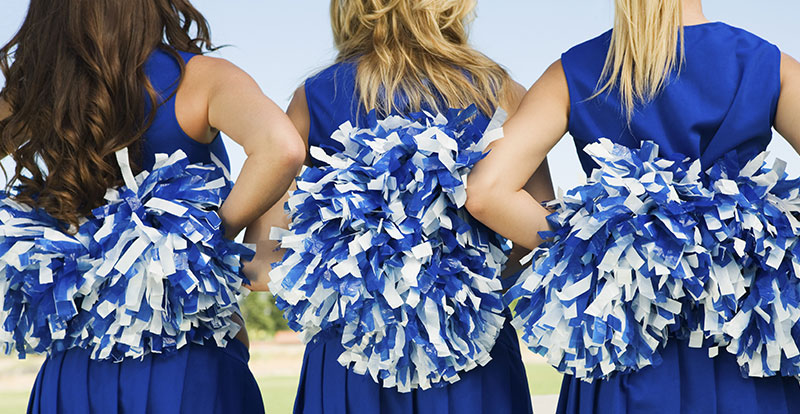Cheerleading: Injuries, Stats and Prevention

Cheerleading is a physically demanding sport and is gaining popularity for both young girls and boys.
It can be very grueling. From tumbling and flipping to jumping and performing high-flying stunts, cheerleading is one of the most rigorous physical activities for young athletes.
And with it, comes the risk of potentially serious injuries.
With nearly 30,000 cheerleaders making trips to the ER each year, protecting these performers from injury is a top priority.
Keep reading to learn more about the dangers of cheerleading, including injuries, safety, and prevention.
Most Common Cheerleading Injuries
Cheerleading is about a lot more than just chanting, shaking pom-poms, and rooting for the home team. It involves tumbling, flipping, jumping, and dangerous stunts.
Here are some of the most common ways that these impressive athletes get hurt.
What is the Most Common Cheerleading Injury?
Cheerleading Concussions are the most common injury among cheerleaders. In fact, 1/3 of all cheerleading injuries are concussions.
When the brain is jolted inside the skull, it can cause acute and long-term damage. Cheerleading concussions are common during stunts for both the flyers and the team members at the base.
Sometimes, cheerleaders fall from a high-flying stunt and hit their heads on the ground. Cheerleaders at the base of a stunt are at risk of being kicked in the head. Falling flyers can also land on cheerleaders below, causing multiple injuries.
Cheerleading Sprains
Cheerleading involves a lot of jumping, pivoting, landing, and tumbling. As a result, sprains are another common injury in cheerleading.
Ankle sprains are common when cheerleaders land awkwardly, rolling their ankle or knee. ACL tears and sprains are serious injuries that can end a young cheerleader’s season or career.
Fractures In Cheerleading
One of the more serious injuries that many cheerleaders experience is fractures to the ankle, wrist, and back. Fractures are common during cheerleading stunts, tumbling, and landing.
An X-ray will determine the severity of a fracture and if it requires casting.
Muscle Strains
There’s no denying how intense and physically demanding cheerleading is. Cheerleaders need strong muscles to propel themselves and other team members through the air and support stunts.
Muscle strains are common due to sudden stress and mostly impact the back, hips, and groin.
When these young cheerleading athletes make sudden, forceful movements, the muscles pull and twist in unnatural ways. Muscle strains are more common among athletes who don’t properly stretch or warm up before engaging in physical activities.
Cheerleading Safety Protocol and Prevention
Despite the present danger, cheerleaders continue to go bigger, more dramatic, and more dangerous with their performances.
The good news is, there are preventative measures you can take to help protect young athletes and safety protocols to follow.
Cheerleaders Should Use Floor Mats
Tumbling is one of the most dangerous physical activities cheerleaders participate in. Using cushioned floor mats can help reduce the risk of common injuries including sprains, fractures, and even concussions.
While landing mats aren’t required, they’re strongly encouraged — especially when attempting new stunts. Many squads use landing mats during practice but forgo them during performances because they’re a nuisance.
Regardless of how inconvenient it is to roll out mats, it could be the difference between a flawless performance and a serious, season-ending injury.
Cheerleading Spotters Should Be Properly Trained
Spotters aren’t the primary support for cheerleading stunts but instead, assist by keeping the stunt steady and balanced. Having spotters who are properly trained is crucial for keeping all members of the team safe.
If you’re trying an especially daring stunt, consider having extra spotters on hand.
Spotters also act as the first point of contact when a flyer is coming down from a fall or dismount.
Cheerleading Pyramid Height Restrictions
Pyramid heights are designed to keep cheerleaders safe and minimize injuries.
High school and college restrictions differ slightly. In high school, one person must always be touching someone else who is in direct contact with the floor. Pyramids shouldn’t be higher than 2 levels.
In college, the base cheerleader must remain in contact with all cheerleaders they’re supporting, as well as the floor. Pyramids shouldn’t be higher than 2.5 body lengths.
Dismounting flyers aren’t permitted to rotate and must keep their head horizontal with their bodies.
Cheerleading Stunt Progression
Before cheerleaders can attempt complex, dangerous stunts, they must first master the basics.
As competition cheer teams attempt more high-risk maneuvers, injuries can start to increase. Coaches must ensure that all team members master basic skills before advancing to more complex stunts and maneuvers.
That’s why proper coaching credentials and training are important parts of cheerleader safety.
Cheerleading Team Insurance Coverage
Following proper safety protocol is one way to ensure cheerleader safety. Investing in cheerleading accident and health insurance is another.
In the event of an accident or injury, cheerleaders can face mounting medical bills and out-of-pocket costs. You can provide them with a solution by carrying general liability insurance with a supplemental accident and health option.
If a cheerleader gets hurt, the parents are initially responsible for all out-of-pocket expenses. In an effort to be made whole again, the family will likely come after you for reimbursement.
Without accident and health insurance, you could be facing a lawsuit and a big payout.
Without coverage, your organization isn’t just at risk of being sued. You may also end up paying hefty medical bills and increased coverage costs down the road.
Avoid these headaches by getting the proper coverage today.
Invest in Added Protection and “Peace of Mind”
Cheerleading is a rigorous and amazing sport to watch and participate in. It’s also more dangerous than people realize.
As cheerleaders run, tumble, and fly high, they’re at risk for serious injury. Protecting yourself against lawsuits in the event of an accident gives you “peace of mind” and financial protection.
Now, these young athletes can give it their all without the worry of unexpected, mounting medical bills.
Get coverage today so your athletes can cheer with confidence!

